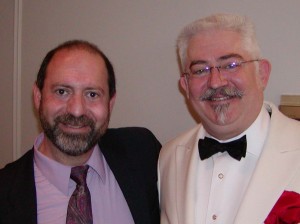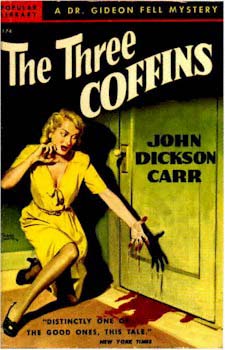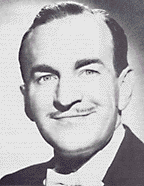Friday, May 9: Bandersnatches
BANDERSNATCHING IN NYC
by Steve Steinbock
I had a great time in New York last week for the Edgars. One of the highlights was the pre-Edgar party hosted by Dell Magazines (EQMM and AHMM). EQMM editor Janet Hutchings announced the winners of the 2007 Readers’ Award. In the top story position were Ed Hoch’s “The Theft of the Ostracized Ostrich” and David Dean’s “Ibrahim’s Eyes.” Ironically, this was the first time Ed Hoch had won the award. As Janet explained, with so many stories nominated each year, votes for Ed’s stories were always spread too thin to get a first place honor.
 It was great catching up with people whom I rarely see more than once a year. Here I am with our Commander, James Lincoln Warren. (He’s the one in the white tux).
It was great catching up with people whom I rarely see more than once a year. Here I am with our Commander, James Lincoln Warren. (He’s the one in the white tux).
The Devil in the Details
 If there’s a mystery fan out there who hasn’t read John Dickson Carr’s The Three Coffins (British title The Hollow Man), then as soon as you finish reading this, dash off to the library or the bookshop or Amazon and grab a copy. Note: styles change, and tastes change with them. Readers from 2008 may have to adjust their internal glasses to bring this 1935 novel into focus. But it’s well worth it.
If there’s a mystery fan out there who hasn’t read John Dickson Carr’s The Three Coffins (British title The Hollow Man), then as soon as you finish reading this, dash off to the library or the bookshop or Amazon and grab a copy. Note: styles change, and tastes change with them. Readers from 2008 may have to adjust their internal glasses to bring this 1935 novel into focus. But it’s well worth it.
In the novel, the obese and verbose Professor Gideon Fell investigates a series of murders committed in apparently impossible conditions, causing people to think that the murderer is invisible. Two-thirds of the way into the novel, Dr. Fell steps out of the action and speaks directly to the reader in the famous “Locked Room Lecture.” In this lecture, Fell explains the various rational explanations for a “Locked Room” murder. The book is well worth reading for this chapter alone.
 In a similar vein, magical theoretician Dariel Fitzkee wrote a book, The Trick Brain (1945), which in effect catalogues the entire world of legerdemain. It’s a taxonomy of tricks. He distinguishes the various types of appearances, vanishes, transpositions, transformations, penetrations, restorations, animations, predictions, and so on that make up a magicians repertoire.
In a similar vein, magical theoretician Dariel Fitzkee wrote a book, The Trick Brain (1945), which in effect catalogues the entire world of legerdemain. It’s a taxonomy of tricks. He distinguishes the various types of appearances, vanishes, transpositions, transformations, penetrations, restorations, animations, predictions, and so on that make up a magicians repertoire.
Fitzkee’s book and Carr’s “lecture” are both examples of the same process. I don’t know what to call it. Deconstruction is a nice word, but it already means something else. Reverse engineering? Anyhow, as similar as these processes are, there’s a significant difference. At the end of a mystery story, during the denouement, all the secrets of the story are revealed, and if it’s a really good mystery, the reader slaps his head and says, “I should have figured that out! It’s so obvious now!” In magic, there is no denouement. The magician keeps the secret to himself. Spectators often try to catch the magician, to figure out the sleight or gimmick that allows for the illusion. But, particularly in the case of a really good trick, if a spectator is told how it’s done, she is invariably disappointed.
Why is it so satisfying to learn the solution of a mystery, and so disappointing to learn the solution of a magic trick? I’m sure there’s a sound psychological explanation for this difference, but it’s beyond me.
For a time, whenever I read a good mystery I would take copious notes on the plot structure. I still have those notes somewhere. They aren’t something I’d share, because I think it would spoil a book for anyone who looked at them. But the process of gathering these notes, rather than detracting from the experience of reading, deepened my enjoyment and appreciation, and gave me a valuable insight into plot structure and suspense.
This past week I started doing it again. This time, rather than analyzing novels, I’ve been cataloguing the literary sleights performed by Ed Hoch in his stories. He wrote a lot of them, and so far I’ve only done a dozen or so of his Nick Velvet stories. Like my earlier plot-breakdowns, I have no intention of sharing my Hoch-notes. They wouldn’t do anyone else any good. It’s sort of like exercise. Watching someone else do it doesn’t take off the pounds.
And there’s the irony: Nick Velvet is a thief who only steals worthless items (like a bald man’s comb, or a lopsided cobweb, or an empty paint can). My notes are the very sort of thing Nick Velvet might be hired to steal. They have no value except to me.
Then again, if Nick Velvet were real enough to steal my notes, and saw that they related his exploits, they’d certainly have value to him. But now I digress.
Be back next week for an Appointment in Samarra.




















[James Lincoln Warren is] the one in the white tux.
Only the dinner jacket was white. The pants were black, as they should be.
I’m not actually through “The Three Coffins” yet,(I have read ABOUT it!) but I think the Locked-Room Lecture is more in the manner of distraction. Namely, the longest red herring. Lordy! “The Longest Red Herring” sounds like a title for a novel. Or a story! And Steve, regarding learning from Mr. Hoch, my suggestion is to read the “Dr. Sam” stories as well. And you can bet that if Ed Hoch had somehow read this post, we’d be reading a story about someone who analyzed all the clever twists and plots in one writer’s mystery stories and decided to use them for crininal ends. Maybe call it; “The Man Who Read Edward D. Hoch.”
Interesting. Brings to mind a long evening spent trying to get Walter Gibson to talk about his The Shadow stories. He’d give a brief answer to a question and then go back to talking about his favorite subject, magic.